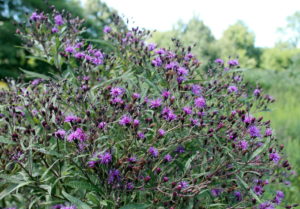Invasiveness Is in the Eye of the Beholder
June 18th, 2019
So I was poking around the fabulous 2019 Chelsea Flower Show last month in London when I came across an educational display on invasive plants.
The British are apparently having as alarming a time with that issue as we are.
But what caught my eye most was what made the invasive list there. Among the familiar culprits of Japanese knotweed, houttuynia, and kudzu was a plant very common to our yards – columbine.
This spring-blooming, U.S. native perennial apparently seeds around as well in England as in America. The difference is that seeding around when you’re not a native makes you an evil invader while seeding around on your home turf makes you a desirably virile choice.
Interesting difference, eh? The same plant with the same characteristics and behavior can be “good” or “bad” depending on who’s doing the judging and where.
American gardeners – like so many Brits – are on a big native-plant kick lately. Some of the more avid native-backers advocate that even cultivars of a native species aren’t worthy of being planted, not to mention making owners of non-native peonies and azaleas feel guilty.
I like many U.S. native plants and think we should plant more of them. But being born in America doesn’t automatically make a plant superior.
For one thing, some natives seed around so much or creep into neighboring territory that they act like weeds (plants in places where they’re not wanted).
You can’t technically call them invasive since you can’t invade where you already reside, but you can call them “weedy” or at least “overly aggressive.”
In my garden, native New York ironweed and hardy ageratum (a.k.a. blue mistflower) got the boot for bad behavior, while I’m careful to cull the beebalm each spring to keep a semi-lid on this super-fast spreader.
Poison ivy isn’t welcome at all, despite being a U.S. native that birds like.
If I didn’t know who was from where, I’d guess columbine was more of an “invasive” plant than, say, lavender or panicle hydrangeas.
The British Royal Horticultural Society recently did some research showing that many “near natives” (plants from nearby regions) were almost as attractive to native British wildlife as native British plants, while even some far-away natives from similar climates were as attractive as well.
The upshot is that not all non-natives are of no value to native bees, butterflies, and other pollinators, which is the main underlying reason behind the back-to-native movement.
When it comes to cultivars of native plants, numerous Master Gardener groups and the guru of the native-plant movement himself – University of Delaware entomologist Dr. Doug Tallamy – are reporting research in which many cultivars are even more attractive to pollinators than straight species.
Both sets of findings seem to conclude that you don’t have to plant a yard full of nothing but natives to be kind to pollinators.
Just avoid invaders/aggressors that can choke out the preferred choices, and plant more diversity – especially a symphony of blooms that hands off color from one to the next from spring through fall. That way, wildlife will have a non-stop buffet and be able to pick what whey like best.
Incidentally, other plants on the U.K.’s invasive or watch lists include lamiastrum, purple loosestrife (which Canadians still like), butterfly bush, crocosmia, skunk cabbage (another U.S. native), cherry laurel, grape hyacinths (still a favorite U.S. spring bulb), and another of our favorite reseeding summer flowers, Verbena bonariensis.









